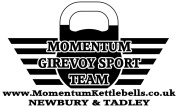About Girevoy Sport
Girevoy sport (GS) is an emerging sport in this country although it is one of Russia's national sports.
‘Girevoy’ is Russian for Kettlebell, and a kettlebell sport competitor is called a ‘Girevik’
The challenges in GS are exceptional. It is a mixture of endurance, strength, power, Flexibility and Technique as well as mental fortitude.
There are 2 main events in GS.
1. Biathlon
2. Long Cycle
1. Biathlon
This event is 2 in 1. The first part is the ‘Jerk’. Ladies use one kettlebell and men use double kettlebells. The Kettlebells are ‘Cleaned’ to the chest, into the ‘Rack’ position. From here they are repeatedly ‘Jerked’ above the head for the maximum amount of repetitions in a 10 minute time limit. Ladies are only allowed to change hands once in the permitted time.
The second part of the Biathlon event is called the ‘Snatch’. In this event both men and ladies use one kettlebell. The kettlebell is repeatedly swung between the legs and then up to the overhead position without stopping. Again the competitor will try and get the maximum amount of repetitions done for a 10 minute time limit. You are only allowed to change hands once in the permitted time.
2. Long cycle (Clean and Jerk)
In this event, like the ‘Jerk’, Ladies use 1 kettlebell and Men use double. The kettlebells are ‘re-cleaned’ into the rack position for every rep and then ‘Jerked’ overhead. Again there is a 10 minute time limit and the competitor will try and get as many repetitions as possible. Ladies are only allowed to change hands once in the permitted time.
In all events the kettlebell is not allowed to touch the floor. If this happens then your ‘set’ is considered over.
There are ranking Tables with each organisation that guides the lifter towards competence with each weight of Kettlebell. Click here to see examples of some of the main organisation's ranking tables.
Each event (Biathlon and Long cycle) can be considered a full body workout, as they both contain elements of pushing and pulling with both the upper and lower body as well as a large amount of core work. There is a massive drain on both the anaerobic and aerobic systems meaning that you will be developing both your strength and cardio at the same time. This is true of kettlebell training for fitness or competitions, but GS takes your training to the next level. The skill, strength and fitness required and developed in GS really cannot be understood until it is experienced.
Here is an excerpt from a Russian study into kettlebell training and its effect on physical abilities:
In the 20th century, Soviet science validated what Russian hard men had known for centuries: kettlebell lifting is one of the best tools for all around physical development.
Voropayev (1983) observed two groups of college students over a period of a few years. To gauge their performance, he used a standard battery of the armed forces physical training (PT) tests: pull-ups, a standing broad jump, a 100- meter sprint, and a 1K run.
The control group followed the typical university PT program, which was military oriented and emphasized the above exercises. The experimental group just lifted kettlebells.
In spite of the lack of practice on the tested drills, the kettlebell group showed better scores in every one of them! Vinogradov and Lukyanov (1986) found a very high correlation between the results posted in a kettlebell lifting competition and in a great range of dissimilar tests: strength, measured with the three powerlifts and grip strength; strength endurance, measured with pull-ups and parallel bar dips; general endurance, determined by a 1K run; and work capacity and balance, measured with special tests.
Lopatin (2000) found a positive correlation between soldiers’ kettlebell sport ranking and their obstacle course performance. Kettlebells improve coordination and agility (Luchkin, 1947; Laputin, 1973). Kettlebells develop professional applied qualities and general physical preparedness (Zikov, 1986; Griban, 1990).
















